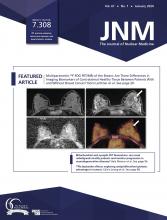Abstract
We assessed the predictive value of new radiomic features characterizing lesion dissemination in baseline 18F-FDG PET and tested whether combining them with baseline metabolic tumor volume (MTV) could improve prediction of progression-free survival (PFS) and overall survival (OS) in diffuse large B-cell lymphoma (DLBCL) patients. Methods: From the LNH073B trial (NCT00498043), patients with advanced-stage DLCBL and 18F-FDG PET/CT images available for review were selected. MTV and several radiomic features, including the distance between the 2 lesions that were farthest apart (Dmaxpatient), were calculated. Receiver-operating-characteristic analysis was used to determine the optimal cutoff for quantitative variables, and Kaplan–Meier survival analyses were performed. Results: With a median age of 46 y, 95 patients were enrolled, half of them treated with R-CHOP biweekly (rituximab, cyclophosphamide, doxorubicin, vincristine, and prednisone) and the other half with R-ACVBP (rituximab, doxorubicin, cyclophosphamide, vindesine, bleomycin, and prednisone), with no significant impact on outcome. Median MTV and Dmaxpatient were 375 cm3 and 45 cm, respectively. The median follow-up was 44 mo. High MTV and Dmaxpatient were adverse factors for PFS (P = 0.027 and P = 0.0003, respectively) and for OS (P = 0.0007 and P = 0.0095, respectively). In multivariate analysis, only Dmaxpatient was significantly associated with PFS (P = 0.0014) whereas both factors remained significant for OS (P = 0.037 and P = 0.0029, respectively). Combining MTV (>384 cm3) and Dmaxpatient (>58 cm) yielded 3 risk groups for PFS (P = 0.0003) and OS (P = 0.0011): high with 2 adverse factors (4-y PFS and OS of 50% and 53%, respectively, n = 18), low with no adverse factor (94% and 97%, n = 36), and an intermediate category with 1 adverse factor (73% and 88%, n = 41). Conclusion: Combining MTV with a parameter reflecting the tumor burden dissemination further improves DLBCL patient risk stratification at staging.
Footnotes
Published online Jun. 14, 2019.
- © 2020 by the Society of Nuclear Medicine and Molecular Imaging.







